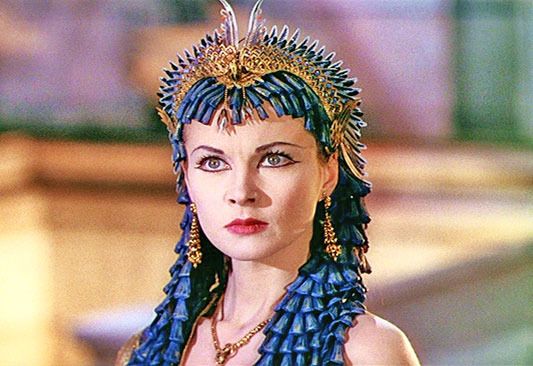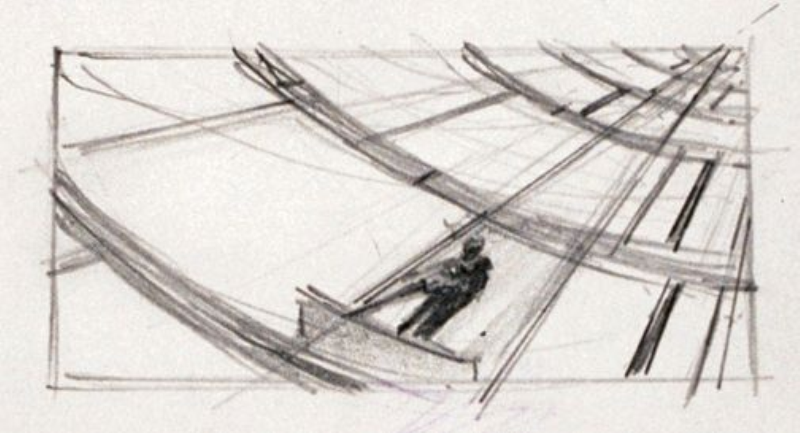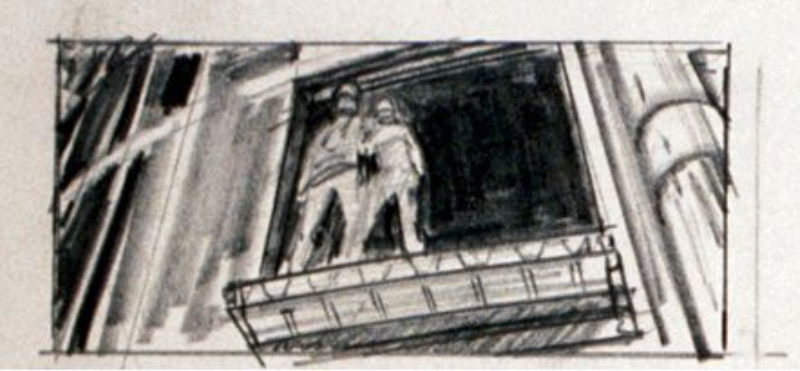“Same story, different versions! And all are true.”
“Time can be rewritten.”
--
“I have heard two variants of the saga of The Star Wars; one in the day and one in the night. It is rather like how ancient Fricanian storytellers were said to tell two different versions of the tales of their greatest heroes, one to the men-folk and one to the women.
"But recently, I have discovered that there are other versions, as well.
“While I was doing research at Woonsocket Technopological Institute, I made a great discovery.
“Pressed between two leaves of The Fabulous Treasure of Big Whoop (volume IIIa of The Secret History of the Monkey Planet), I found a fragmentary, but neatly folded, series of papers, written in a fine yet spidery hand.
“These hold the secrets of a third, heretofore lost, version of the ancient epic of The Star Wars. This version is more fantastic than any yet told… and yet, perhaps, more true.
“And yet, this new telling itself is divided in twain. The pages on which it is written contain two columns, whose content is similar, yet not identical. One might, perhaps, call them… synoptic.
“Who knows? The manuscript may be a forgery. I already know what I think. But you must judge with your own eyes.”
--Preface to The Mercury Diaries, by C. Trottier
--
“The left-hand column of the Woonsocket Manuscript gives an entirely different account of the origins of Luke Starkiller, one sure to be of much interest to scholars of The Star Wars.
“The manuscript concurs with previously known sources in stating that Annikin was restored to health by a girl of the Thorpe family of Utapau after a starflyer crash. Where it diverges, however, is in the question of precisely which woman he loved—rather like the tales of Sigurth of Old Norway, and his two wives.
“By this account, Annikin fell in love, not with Beru as is commonly said, but with her sister Breha—and it was she who had the kindly brown eyes that ensnared Annikin so. But Beru was the elder sister, and she was jealous of her sibling’s easy familiarity with men. So, with her father’s connivance, she seduced Annikin by aid of a potion poured into his drink, which addled his wits.
“And Annikin slept with Beru… and thus he, not Lando Kadar, was the true father of Luke Skywalker.
“Before Annikin departed Utapau for that time, he told Beru that it would be wiser to raise the boy in ignorance of her true relationship to him. For, should anything happen to Annikin, young Luke might thus be spared the wrath of a corrupt Republic in turbulent times.
"To this deception Breha, who had badly wanted a child of her own from Annikin, also agreed.
“Lastly, to protect his son further, Annikin gave Luke a parting gift: a new surname that was also an alias. Luke Starkiller. In this telling, the Starkiller name was not, it would seem, an honorific of battle.”
--The Mercury Diaries, pp. 5-6
--
“….the left-hand column of the Woonsocket Manuscript adheres to the traditional assertion that Leia Organa was the daughter of Annikin Starkiller.
“The right-hand column, however, tells a different story. After all, Queen Alana was a very beautiful woman, and Annikin Starkiller was not the only Jedi in her husband’s service who loved her from afar.
“As a direct corollary, the right-hand variant of the manuscript relates that Luke Starkiller had a twin sister, born like him upon Utapau. But Annikin took his own infant daughter away, to be raised on Ton-Muund, among a noble household of the Republic.
“Already, he feared that the Republic was in danger of passing away, and that it needed well-protected heroes if it were to survive. And in his heart, Annikin guessed that a young woman would have the resilience to survive in the Republic’s capital, whereas a young man might wither and die as his dreams shattered before his eyes.”
--The Mercury Diaries, p. 9
--
“It must be stressed that neither column of the Woonsocket Manuscript makes reference to an element of the received tale which many scholars have taken as a later interpolation: the magic Rings, stemming from the whole episode of the Elves and Dwarves on Bestine.
“Although it is quite likely that the Elves and Dwarves (or, to give them their proper Old High Galactic names, the Sith and Boma) were part of the tale from the outset, the extreme antiquity of the Woonsocket Manuscript makes it probable that Annikin’s fabulous magic Rings were not in fact originally part of the saga of The Star Wars.
“The overall consequences for the story may be summarized thusly:
“Darth Vader is no longer the changeling child of an Elf, but simply an evil and corrupted Jedi; the minor character of Laif Organa, who is often judged to be extraneous, disappears entirely; and Annikin Starkiller’s own parentage remains mysterious.”
--The Mercury Diaries, p. 11
--
Here follow excerpts from the lone surviving copy of the first edition, suppressed by decree of the Third Republic, of Friar J.A. Humbert’s controversial treatise The Secret Mysteries of the Whills:
Perhaps I might pause here to describe what this long-lost ritual of initiation is. I have learned of it only imperfectly, but that there was one, there can be little doubt. It is, shall we say, self-evident, to one who knows something of the Elves.
It was not, as is even now commonly believed among laymen, a method of torture by a cruel and capricious order of Dark wizards—those impostors who falsely arrogated to themselves the name of Sith. Rather, it was meant as a revelation of sorts.
The true Sith, the Elves, wished only to cause pain in small doses, so as to bring about far greater pleasure. For their motto was that of the Heroic Serpent, the Brother of Angels: “An it harm none, do what thou wilt.” To that end, they wished their ordeal of initiation to encompass their philosophy in itself.
Four times would an initiate be asked to submit to the rule of the Sith. For each of the first three refusals, a series of seven physical punishments would be administered, with intervals of several days (the exact number, I know not) elapsing between the stages of punishment.
Upon the fourth refusal, the punishment (or reward?) for one so obstinate was the ultimate sanction: death.
(Of this last part of the ritual one cryptic descriptive phrase has survived: “He will knock four times….”)
There were seven steps in the initial ordeal, of which each had three stages.
They were as follows:
I. Injury to the hair:
a. A lock of hair clipped
b. The head (and beard, for men) shaved
c. The head shaved, and part of the hair permanently removed (the beard sans mustache, for men; most of the head hair, for women, in a fashion subject to personal taste)
II. Injury to the right eye:
a. The right eye blackened and swollen shut
b. The right eye blinded
c. The right eye cut out
III. Injury to the nose: broken once for each refusal to submit
IV. Extraction of the teeth:
a. One tooth removed
b. Nine teeth removed
c. All teeth removed
V. Physical violation, in increasing severity
VI. Injury to the trunk:
a. Flogging on the back
b. Flogging on the chest front
c. Asymmetrical removal of one organ of reproduction
VII. Injury to the right hand:
a. The right ring finger removed
b. The last three fingers of the right hand removed
c. The right hand removed in toto
Once an inductee submitted, they received the Final Stage of initiation, the Seven Seals of the Sith:
I. Drinking of a secret Sith liquor that brings on madness and ecstasy, an exalted state referred to as the Red Draught of the Sith (cf. the Black Sleep of Kali in the Silver River Galaxy)
II. Application of the Mark of the Sith to the forehead, in such a way as to show the rank of the novitiate:
a. For the once-resistant, a black triskelion tattoo
b. For the twice-resistant, a red triskelion tattoo
c. For the thrice-resistant, a triskelion of molten gold poured into a cicatrix carved on the forehead
d. For those who never resisted, a triskelion brand on the forehead, assuming the natural color of the skin (a “proper” blazon, in the language of heraldry)
III. The application of wounds willingly undergone by the initiate: one for each prior refusal of submission, plus another in addition. These take the form of rituals left undone, and at least one of them must be done to the ultimate degree. However, those who refused to submit three times are spared this final seal, as they have already done all that is necessary and proper.
IV. A banquet, at which—
Here, sadly, the sole surviving manuscript breaks off in a lacuna.
A later page tells more:
To hide the marks upon their foreheads, most Sith Lords wore masks, for they did not wish it to be widely known, even within the Empire, that they served a master greater and more powerful than the Emperor—whose emblem remained the arrowhead of the still-venerated Old Republic.
Yet in truth, some Sith initiation candidates were drawn from the Imperial officer corps. These, who had already given their sworn word to submit, instead wore their marks upon their left forearms, where they might be easily concealed.
These secret Sith Lords were held in pectore, or “in the breast,” until such time as they were ready to be received openly as Sith Knights. At that point they would have completed their training, in public and in private—the full details of which even I have not yet uncovered.
--
Excerpted from the Woonsocket Manuscript text of The Star Wars, as published by C. Trottier:
Episode III: To Duel in Hell
By the time of the Third Clone War, Annikin too had grown: he was now a mature man, with gray just beginning to touch his hair. He held the rank of Second Master in the Great Council of the Jedi Order. He was second only to Bunden Debannen, the wizened and shrunken Grand Master of the Order—who instructed all younglings when they first joined the Jedi, regardless of their age.
(Remember, at this early stage, it seems that anyone could be a Jedi. But, just like learning a new language, I’m sure that youthfulness greatly helped new candidates to be mentally flexible.)
Naturally, by virtue of his own great age, Bunden (who was playful, and preferred the nickname “Buffy”) was the one most experienced in helping new students unlearn what they had learned in their prior lives.
--
When Annikin disposed of his daughter with a foster family on Ton-Muund, and retired to Utapau as a moisture farmer, Ben Kenobi took up his place as the second-in-command of the Jedi Order. However, there were many in the Great Council who spoke against his appointment, fearing that Ben was too tempted by the lure of the Dark Side.
But Bunden Debannen, ancient yet still hale, said it was a good choice, and this swayed the doubters. And old “Buffy” whispered secret words of counsel to Ben, which no one else heard. For Ben did not yet reveal them.
--
As the darkness gathered, Grand Master Debannen took shelter on a remote asteroid base. Here he struggled mightily for the cause in his own way. But he was no warrior, and he did not wield a lightsaber. Instead he pitted himself against a vast, unseen darkness: a black void of a spirit, insubstantial and devilish, only barely glimpsed by the Sith themselves through dark mirrors.
He did not win… as yet. For the Empire and the corrupted Sith Order were still in the ascendant.
--
Choose Your Own Adventure time!
>TENNO
>TOMOE
You chose: TENNO
The night before the Battle of Condawn, Annikin slept with Alana one last time.
Nine months later, Leia Organa was born. She would grow up to be a beautiful, golden-haired child, the very image of her dead father.
You chose: TOMOE
The night before the Battle of Condawn, Ben Kenobi feared that his own death was imminent. So he at last gave in to long-standing temptation, and slept with his beloved Queen Alana of Organa Major.
Nine months later, Leia Organa was born. She would grow up to be a beautiful, raven-haired child, the very image of her absent father.
--
Few Jedi, even those already committed to the Sith, ever used any lightsaber color other than red.
But Ben Kenobi, the most unorthodox of the current-day Jedi, had done something no other Jedi would have dared. Ben’s lightsaber blade shone white.
So, on the day of their their great duel, Ben and Vader’s contrasting white and red lightsabers scintillated against the red flames of Condawn.
--
During their battle, Ben Kenobi saw an opening, and pulled Lando’s Kiber Crystal from its chain around his neck, hoping thus to depower him. And Lando, not yet knowing the truth about the Crystals’ power, thought that he had indeed been rendered powerless.
Ben cut off Lando’s right hand, and stabbed him in the chest with his lightsaber. But Lando, despite his grave injuries, still lived—which surprised even him.
As Lando lay on the ground, Ben Kenobi taunted him, and ordered him to yield.
But Lando was not one to give up so easily.
Snatching up his fallen lightsaber in a sudden movement, Lando rose and attacked Ben Kenobi. In an instant the tables were turned. Now Lando had cut off Ben’s right hand, and it was the Jedi who lay fallen upon the blackened ground.
Cruel in victory, Lando stole Ben’s unique sword, his Kiber Crystal, and Laif’s damaged saber hilt, as trophies for the new Sith Order. Annikin’s and Laif’s Kiber Crystals, however, had disintegrated with their owners’ demise, for they had not been passed on beforehand.
(Ben mentions his lost Kiber Crystal at one point in the 1975 third draft. The idea of a Kiber Crystal dissolving when its possessor dies comes from a trait of the magical Lenses in Doc Smith’s Lensman books.)
But in recompense for taking away Ben’s sword, Lando left Annikin’s sword for him to have, that Ben might pass it on to Luke. After all, what good had it done its original owner?
And so, Lando walked off, triumphant, leaving the wounded Ben Kenobi to grieve by his fallen King and his dead friends.
He was all the more triumphant because, when he defeated Ben Kenobi, he had felt the Force stirring still within him. Now he knew that he no longer had any need for the Kiber Crystals, and he rejoiced in his new freedom. But Lando kept this knowledge secret, since not even the Jedi knew this as yet—save one only, who thought it best for other Jedi to learn this for themselves.
--
I might pause to point out here that, as far as I’m aware, the earliest known mention of Vader being pushed into a lava pit in The Duel is actually in the 1977 Rolling Stone interview with GL. The text of GL’s 1975 discussion with Alan Dean Foster, however, says only that Ben and Vader have a "big battle where Luke’s father gets killed.”
Also, here I’m pulling in an additional comics history reference, to Dr. Doom of the Fantastic Four.
The common story, the original canon of the Marvel universe, is that Dr. Doom was horribly burned in a lab experiment, and hid his features behind iron armor as a result. But the artist, Jack Kirby, himself believed that Doom only had a small facial scar, and hid his handsome face behind a mask out of pure vanity.
--
Bunden Debannen went off into seclusion in the wake of Condawn, to live on an unknown and yet-uncharted planet at the edge of the galaxy, shrouded in fog and mist. Here he would strive against the greatest evil, as yet unseen by Men—the Dark Side itself—in privacy.
He was not seen by any Jedi again, nor any human, for many years afterward.


